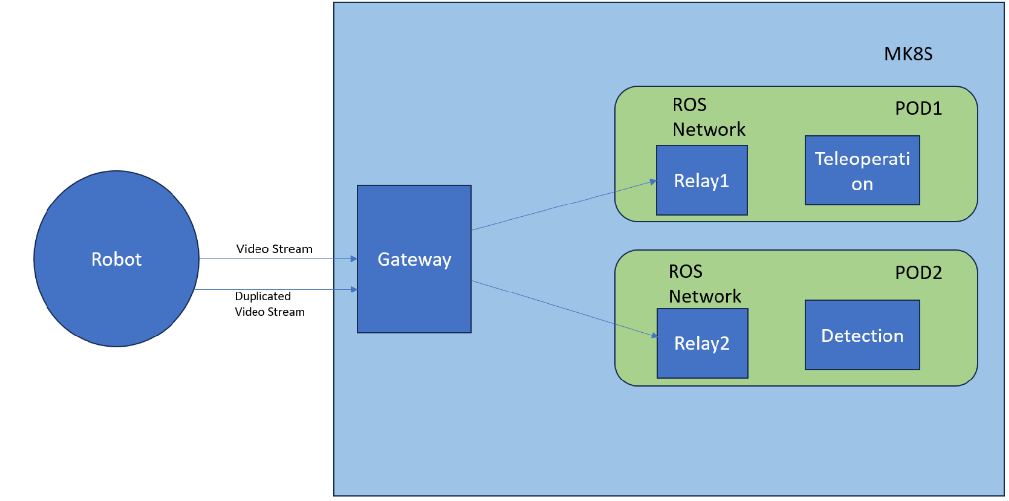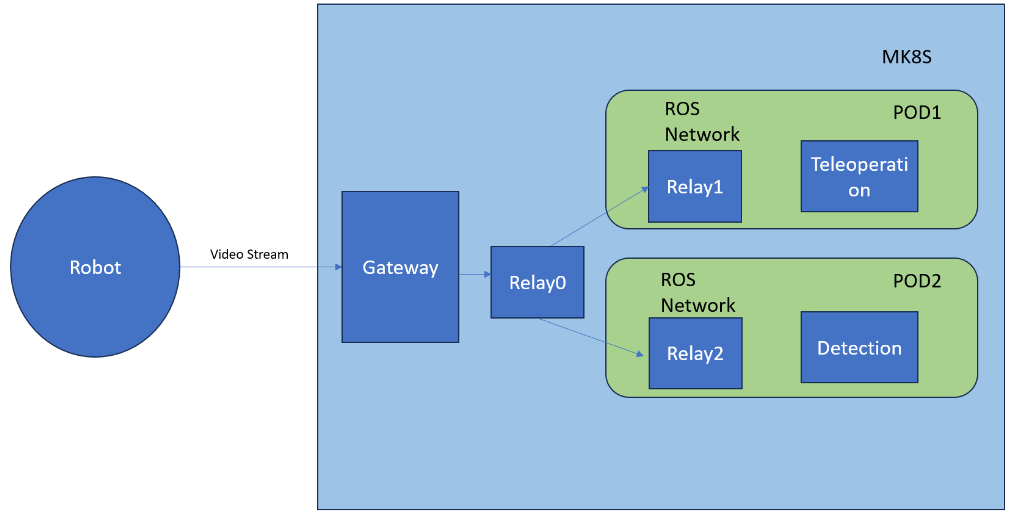This repository contains the Relay Network Application, which enables the seamsles transition of ROS-based application from local deployments to remote deployments on cloud- or edge-devices. It uses methods of Rosbridge-suite for translation of ROS messages to JSON and vice versa. The Socket.IO library is used for transport of the data between robot and edge/cloud. It allows to mirror topics from robot to edge/server and vice versa. Moreover, it supports service calls from robot to edge/cloud.
The Relay Network Application consists of three parts: Relay Client, Relay Server and Relay Inter.
The Relay Client runs on robot and initiates the connection to the Relay Server. For configuration, there are two enviroment variables, TOPIC_LIST and SERVICE_LIST. The former is used to specify the topics, which should be mirrored to the remote ROS environment. The later specifies the list of remote services, which should be provided to the robot. The variables are specidied in JSON format:
TOPIC_LIST = [
{
"topic_name":"/axis/image_raw",
"topic_name_remapped":"/image_raw",
"topic_type":"sensor_msgs/Image"
},
{
"topic_name":"/test_str",
"topic_type":"std_msgs/String"
}
]The topic_name field specify the local name of the topic i.e., the name under which the robot provides certain data. The optional topic_name_remapped field specify the remote name of the topic, i.e., the name under which the remote application expects the data. If the field is omitted, the topic_name is used for remote publisher. This is an alternative to the ROS remapping, using either rosrun argument or launch parameter. The topic_type field contains the textual representation of the topic's type, e.g., sensor_msgs/Image.
SERVICE_LIST = [
{
"service_name":"/test_srvs",
"service_type":"std_srvs/SetBool"
},
{
"service_name":"/test_srvs2",
"service_type":"std_srvs/SetBool"
}
]The service_name field specify the name of the remote service, that should be advertised to the robot. The service_type field contains the textual representation of the service's type, e.g., std_srvs/Trigger.
To set the connection to the Relay Server or Relay Inter, following env variable are used:
- USE_MIDDLEWARE (bool): Specify if the 5G-ERA middleware is asked to run the remote network application.
- NETAPP_ADDRESS (str): IP address or hostname of the computer, where the netapp is deployed, including schema and port number (e.g., http://remote-server:5896). Only valid if USE_MIDDLEWARE is false, otherwise is ignored.
- MIDDLEWARE_ADDRESS (str): IP address or hostname of the middleware server without schema (e.g.: 127.0.0.1)
- MIDDLEWARE_USER (str): The UUID of the middleware user.
- MIDDLEWARE_PASSWORD (str): Password of the middleware user.
- MIDDLEWARE_TASK_ID (str): UUID of the task to be deployed.
- MIDDLEWARE_ROBOT_ID (str): UUID of the robot.
All env variables with MIDDLEWARE prefix are ignored if USE_MIDDLEWARE is set to false.
The Relay Server is supposed to be deployed on remote edge/cloud device. It recieves protocol messages from one or more Relay Clients and publishes them to the remote ROS environment. The configuration is provided using the TOPIC_LIST environment variable:
TOPIC_LIST = [
{
"topic_name":"/axis/image_raw",
"topic_name_remapped":"/image_raw",
"topic_type":"sensor_msgs/Image"
},
{
"topic_name":"/test_str",
"topic_type":"std_msgs/String"
}
]The variable description is the same as in the Relay Client. It specifies the topics, that should be mirrored from edge/cloud to the robot. The topic_name_remapped could be specified, but it is currently ignored.
The robot runs two Relay Clients and there are two Relay Servers deployed on two independent ROS environments (Relay1, Relay2).
The Relay Inter serves as a router, which can route the data from one robot, to multiple edge/cloud environments. The main intention is to minimize multiple sending of the same data from robot to cloud, which could be expensive when low-bandwith connection is used. The configuration is provided with RELAYS_LIST env variable:
RELAYS_LIST = [
{
"relay_address":"http://localhost:5888",
"topics":[
"/image_raw",
"/test_str"
],
"services": [
"/test_srvs"
]
},
{
"relay_address":"http://localhost:5999",
"topics":[
"/image_raw"
],
"services": [
"/test_srvs2"
]
}
]It contains a list of Relay Servers the Relay Inter should connect to. The relay_address is a address of the remote Relay Server, including the schema and port number. The topics filed contain list of topics, that should be routed to this Relay Server. The same is with services field.
The robot runs one Relay Client, which is connected to the Relay Inter in the cloud (Relay0). The Relay Inter is connected to two Relay Servers (Relay1, Relay2).
Currently, only ROS1 (noetic) is supported. The support for ROS2 is comming soon.
TBA
TBA
TBA

